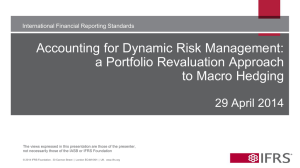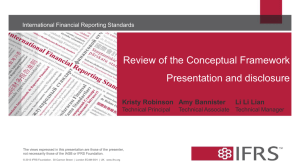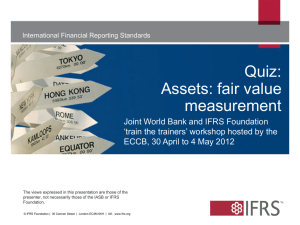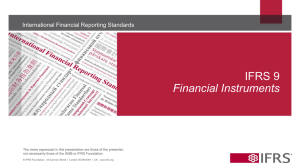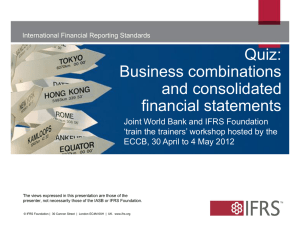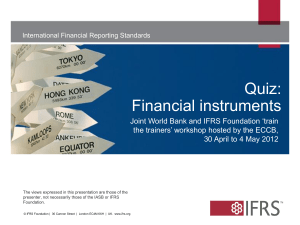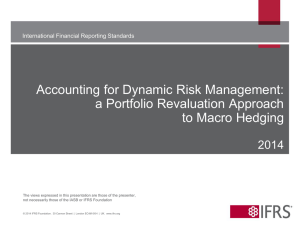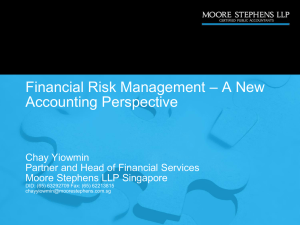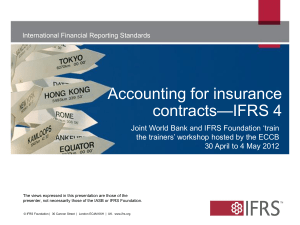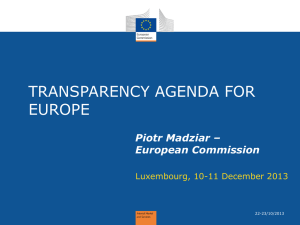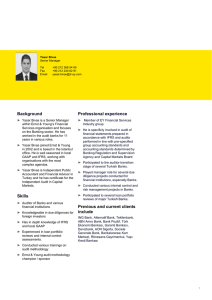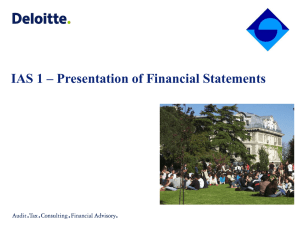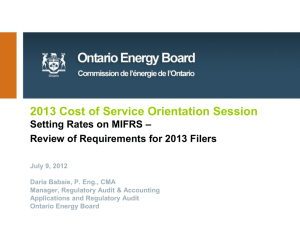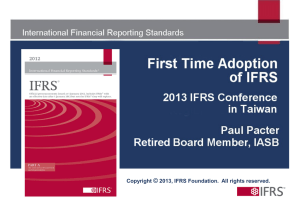Quiz: Reporting financial performance
advertisement
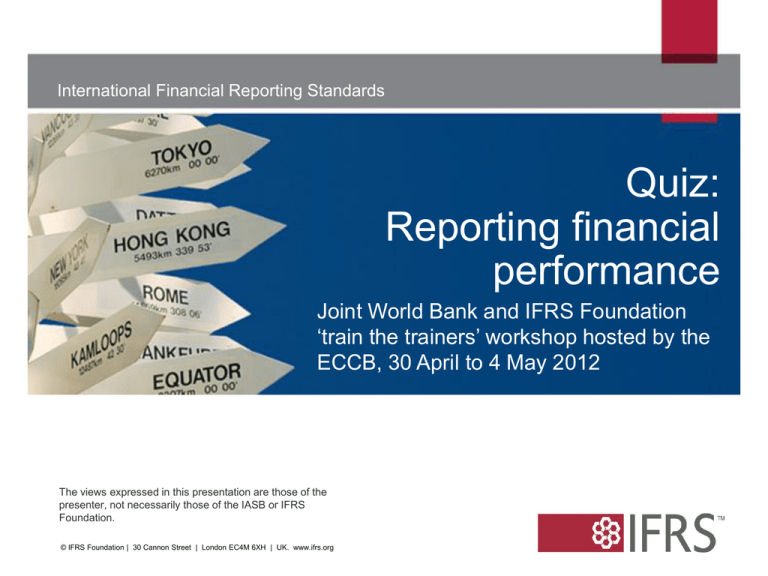
International Financial Reporting Standards Quiz: Reporting financial performance Joint World Bank and IFRS Foundation ‘train the trainers’ workshop hosted by the ECCB, 30 April to 4 May 2012 The views expressed in this presentation are those of the The views expressed in this presentation areor those presenter, not necessarily those of the IASB IFRSof the presenter, Foundation. not necessarily those of the IASB or IFRS Foundation. © IFRS Foundation | 30 Cannon Street | London EC4M 6XH | UK. www.ifrs.org Quiz: Reporting financial performance 2 Question 1: Which of the following are not within the scope of IAS 18 Revenue? a. Revenue from lease agreements? b. Changes in FV of financial assets and financial liabilities or their disposal? c. Change in FV of biological assets relating to agricultural activity? d. All of the above? © IFRS Foundation | 30 Cannon Street | London EC4M 6XH | UK | www.ifrs.org Quiz: Reporting financial performance 3 Question 1: Which of the following are not within the scope of IAS 18 Revenue? a. Revenue from lease agreements? b. Changes in FV of financial assets and financial liabilities or their disposal? c. Change in FV of biological assets relating to agricultural activity? d. All of the above © IFRS Foundation | 30 Cannon Street | London EC4M 6XH | UK | www.ifrs.org Quiz: Reporting financial performance 4 Question 2: Goods with list price of 1,000 sold to customer on normal credit terms. Customer pays 690 in full settlement. The 690 = 1,000 list, less 200 trade discount, less 100 volume rebate, less 10 prompt payment discount. Of the 690, 50 is sales tax to be remitted to government. How much revenue should be recognised? a. 640? b. 1,000? c. 700? d. 690? © IFRS Foundation | 30 Cannon Street | London EC4M 6XH | UK. www.ifrs.org Quiz: Reporting financial performance 5 Question 2: How much revenue should be recognised? a. 640? b. 1,000? c. 700? d. 690? 1,000 list price less 200 trade discount less 100 volume rebate less 10 prompt-settlement discount less 50 sales tax collected on behalf of the government = 640. © IFRS Foundation | 30 Cannon Street | London EC4M 6XH | UK. www.ifrs.org Quiz: Reporting financial performance 6 Question 3: Percentage of completion must be used to recognise revenue from: a. rendering of services and construction contracts? b. rendering of services only when the outcome can be estimated reliably? c. construction contracts only when the outcome can be estimated reliably? d. both b and c? © IFRS Foundation | 30 Cannon Street | London EC4M 6XH | UK. www.ifrs.org Quiz: Reporting financial performance 7 Question 3: Percentage of completion must be used to recognise revenue from: a. rendering of services and construction contracts? b. rendering of services only when the outcome can be estimated reliably? c. construction contracts only when the outcome can be estimated reliably? d. both b and c? © IFRS Foundation | 30 Cannon Street | London EC4M 6XH | UK. www.ifrs.org Quiz: Reporting financial performance 8 Question 4: Car dealer sales promotion—free servicing and 2-years zero interest credit. Recognise revenue separately for: a. entirely sale of goods? b. sale of goods and rendering of maintenance services? c. sale of goods, rendering of services, and a financing element (interest) related to the deferred payment? © IFRS Foundation | 30 Cannon Street | London EC4M 6XH | UK. www.ifrs.org Quiz: Reporting financial performance 9 Question 4: Car dealer sales promotion —free servicing and 2-years zero interest credit. Recognise revenue separately for: a. entirely sale of goods? b. sale of goods and rendering of maintenance services? c. sale of goods, rendering of services, and a financing element (interest) related to the deferred payment? © IFRS Foundation | 30 Cannon Street | London EC4M 6XH | UK. www.ifrs.org Quiz: Reporting financial performance 10 Question 5: A sells goods to B for 950 on 1/1/20X1, and incurs selling cost of 20 at the same time. B negotiates one year interest-free credit (payment due 31/12/20X1). If B had borrowed to pay up front, interest rate = 10%. How much revenue from sale of goods does A recognise at 1/1/20X1? a. 950? b. 863? c. 970 d. 930? © IFRS Foundation | 30 Cannon Street | London EC4M 6XH | UK. www.ifrs.org Quiz: Reporting financial performance 11 Question 5: How much revenue from sale of goods does A recognise at 1/1/20X1? a. 950? b. 863? c. 970 d. 930? A financing transaction is included. Calculation: 950 ÷ 1.10 = 863. ¶23.5 © IFRS Foundation | 30 Cannon Street | London EC4M 6XH | UK. www.ifrs.org Quiz: Reporting financial performance 12 Question 6: Fixed price construction contract 1,000,000. Contractor incurs costs of 10,000, 890,000, and 200,000 in Years 1, 2, 3. At end of Year 1 outcome cannot be estimated reliably, but 10,000 costs are recoverable. At end of Year 2, can make a reliable estimate of 200,000 future costs to complete. How much revenue and cost should contractor recognise in Year 2? See next slide... © IFRS Foundation | 30 Cannon Street | London EC4M 6XH | UK. www.ifrs.org Quiz: Reporting financial performance Question 6 continued How much revenue and cost should contractor recognise in Year 2? a. b. c. d. Revenue 818,182 and costs 900,000? Revenue 808,182 and costs 890,000? Revenue 808,182 and costs 908,182? Revenue 808,182 and costs 900,000? © IFRS Foundation | 30 Cannon Street | London EC4M 6XH | UK. www.ifrs.org 13 Quiz: Reporting financial performance Question 6 continued How much revenue and cost should contractor recognise in Year 2? a. Revenue 818,182 and costs 900,000? b. Revenue 808,182 and costs 890,000? c. Revenue 808,182 and costs 908,182? See next slide d. Revenue 808,182 and costs 900,000? © IFRS Foundation | 30 Cannon Street | London EC4M 6XH | UK. www.ifrs.org 14 Quiz: Reporting financial performance 15 Revenue = 900,000 costs for work performed ÷ 1,100,000 total expected costs = 81.82% completion x 1,000,000 price = 818,182 contract revenue recognised to end of Year 2. 818,182 less 10,000 revenue recognised in Year 1 (limited to recoverable costs) = 808,182 recognised in Year 2. continued... © IFRS Foundation | 30 Cannon Street | London EC4M 6XH | UK. www.ifrs.org Quiz: Reporting financial performance Cost = 81.82% x 1,100,000 expected total = 900,000 recognised to end of Year 2. 900,000 less 10,000 costs recognised in Year 1 = 890,000 recognised Year 2. BUT, total contract costs will exceed total revenue, so recognise additional loss: Total revenue 1,000,000 less 818,182 already recognised = 181,818 for Year 3. Expected costs Year 3 = 200,000. Excess Year 3 costs over revenue = 18,182 loss in Year 2. Expense Year 2 = 908,182 = 890,000 incurred + 18,182 in respect of the onerous contract. © IFRS Foundation | 30 Cannon Street | London EC4M 6XH | UK. www.ifrs.org 16 Quiz: Reporting financial performance 17 Question 7: A government grant is: a. assistance from the government in the form of a transfer of resources to an entity in return for past or future compliance with specified conditions relating to the operating activities of the entity. b. unconditional assistance from the government in the form of a transfer of resources to an entity. c. any type of assistance from the government to the entity from which the entity has benefited directly. © IFRS Foundation | 30 Cannon Street | London EC4M 6XH | UK. www.ifrs.org Quiz: Reporting financial performance 18 Question 7: A government grant is: a. assistance from the government in the form of a transfer of resources to an entity in return for past or future compliance with specified conditions relating to the operating activities of the entity. b. unconditional assistance from the government in the form of a transfer of resources to an entity. c. any type of assistance from the government to the entity from which the entity has benefited directly. © IFRS Foundation | 30 Cannon Street | London EC4M 6XH | UK. www.ifrs.org Quiz: Reporting financial performance 19 Question 8: Government grants exclude which of the following forms of government assistance? a. those forms of government assistance that cannot reasonably have a value placed upon them. b. transactions with government that cannot be distinguished from the normal trading transactions of the entity. c. both (a) and (b). © IFRS Foundation | 30 Cannon Street | London EC4M 6XH | UK. www.ifrs.org Quiz: Reporting financial performance 20 Question 8: Government grants exclude which of the following forms of government assistance? a. those forms of government assistance that cannot reasonably have a value placed upon them. b. transactions with government that cannot be distinguished from the normal trading transactions of the entity. c. both (a) and (b). © IFRS Foundation | 30 Cannon Street | London EC4M 6XH | UK. www.ifrs.org Quiz: Reporting financial performance Question 9: An entity must measure all government grants: a. at the amount of cash or cash equivalents received b. at the amount of cash or cash equivalents received or receivable c. at the fair value of the asset received or receivable d. none of the above © IFRS Foundation | 30 Cannon Street | London EC4M 6XH | UK. www.ifrs.org 21 Quiz: Reporting financial performance Question 9: An entity must measure all government grants: a. at the amount of cash or cash equivalents received b. at the amount of cash or cash equivalents received or receivable c. at the fair value of the asset received or receivable d. none of the above © IFRS Foundation | 30 Cannon Street | London EC4M 6XH | UK. www.ifrs.org 22 Quiz: Reporting financial performance 23 Question 10: The numerator used in the calculation of basic earnings per share is the: a. profit or loss attributable to all holders of all shares issued by the parent entity b. profit or loss attributable to all holders of ordinary shares issued by the parent entity c. profit or loss attributable to all holders of ordinary shares issued by the parent entity and its subsidiaries © IFRS Foundation | 30 Cannon Street | London EC4M 6XH | UK. www.ifrs.org Quiz: Reporting financial performance 24 Question 10: The numerator used in the calculation of basic earnings per share is the: a. profit or loss attributable to all holders of all shares issued by the parent entity b. profit or loss attributable to all holders of ordinary shares issued by the parent entity c. profit or loss attributable to all holders of ordinary shares issued by the parent entity and its subsidiaries © IFRS Foundation | 30 Cannon Street | London EC4M 6XH | UK. www.ifrs.org Quiz: Reporting financial performance 25 Question 11: A potential ordinary share shall be treated as dilutive when conversion to ordinary shares would: a. decrease earnings per share from continuing operations b. increase loss per share from continuing operations c. both a. and b. © IFRS Foundation | 30 Cannon Street | London EC4M 6XH | UK. www.ifrs.org Quiz: Reporting financial performance 26 Question 11: A potential ordinary share shall be treated as dilutive when conversion to ordinary shares would: a. decrease earnings per share from continuing operations b. increase loss per share from continuing operations c. both a. and b. © IFRS Foundation | 30 Cannon Street | London EC4M 6XH | UK. www.ifrs.org Questions or comments? Expressions of individual views by members of the IASB and its staff are encouraged. The views expressed in this presentation are those of the presenter. Official positions of the IASB on accounting matters are determined only after extensive due process and deliberation. © IFRS Foundation | 30 Cannon Street | London EC4M 6XH | UK. www.ifrs.org 27 28 The requirements are set out in International Financial Reporting Standards (IFRSs), as issued by the IASB at 1 January 2012 with an effective date after 1 January 2012 but not the IFRSs they will replace. The IFRS Foundation, the authors, the presenters and the publishers do not accept responsibility for loss caused to any person who acts or refrains from acting in reliance on the material in this PowerPoint presentation, whether such loss is caused by negligence or otherwise. © IFRS Foundation | 30 Cannon Street | London EC4M 6XH | UK | www.ifrs.org
